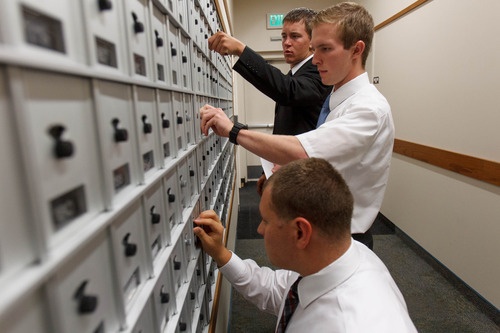This is an archived article that was published on sltrib.com in 2013, and information in the article may be outdated. It is provided only for personal research purposes and may not be reprinted.
The LDS Church plans to expand its flagship Missionary Training Center to the south — even closer to the faith's flagship university.
The Salt Lake City-based Church of Jesus Christ of Latter-day Saints made the announcement late Thursday, saying the 35-acre MTC will take over an area now home to Brigham Young University's Laundry Building and Auxiliary Maintenance Building near University Parkway.
"Design of the expansion is ongoing," church spokesman Cody Craynor said in a statement, "and further details will be provided in neighborhood meetings and in announcements in the coming months."
The move south was one of two options for extending the MTC unveiled in the spring as LDS officials explored ways to handle the ballooning number of missionaries without intruding on surrounding neighborhoods.
The other option was to stretch the MTC campus to the northeast on land in front of the Provo LDS Temple.
Previously, church officials had proposed a nine-story tower to replace three MTC classroom buildings, but a number of residents complained that the high-rise would destroy the character of their neighborhood and violate a supposed promise church officials made nearly 40 years ago to limit the height of MTC buildings.
Tensions mounted when an LDS stake president — who oversees a number of Mormon congregations — asked the neighbors to back church leaders in their MTC plan, which he labeled an ecclesiastical issue.
Several months later, in October 2012, LDS leaders scrapped those plans six days after church President Thomas S. Monson announced lower ages for Mormon missionaries — 18 for men (down from 19) and 19 for women (down from 21). Since then, the number of missionaries has skyrocketed from 58,500 to more than 80,000, including a dramatic surge in female volunteers.
"Expansion of the MTC is necessary," the church said at the time, "but we are confident we can find a solution that builds upon the long-standing working relationship between the MTC, BYU and the community at large."
Thursday's church statement did not indicate what types of buildings were being envisioned for the south expansion.
Gary McGinn, Provo's director of community development, said late Thursday that the church has yet to file site plans or designs with the city for the MTC expansion.
The church has been working with the community to come up with an acceptable solution, McGinn added, though Thursday's announcement was the first time the city learned of the decision to build south.
McGinn said the church has helped develop a new proposed zone in the city that addresses some concerns raised in the past. The new zone would restrict building heights to 100 feet, determine new setbacks and raise the possibility of shared parking with BYU.
A proposal with the new zoning rules, which the Planning Commission has already endorsed, is expected to go to the City Council in December, but McGinn anticipates it will pass and cover the newly announced MTC expansion.
McGinn praised the church for its work on creating the new restrictions.
"That was really a good-faith, voluntary process that they went into to be a good neighbor," he said. "I really do have to take my hat off to the LDS Church for being willing to come in and voluntarily reduce their ability to do things."
Several neighbors who opposed the original nine-story, 160-foot building could not immediately be reached for comment Thursday night. But McGinn believes most residents will be pleased with the decision to expand southward.
The Provo MTC — one of more than a dozen across the globe but by far the largest — had typically housed an average of 2,700 missionaries at any one time. That number mushroomed by the thousands during the summer.
MTCs are boot camps of sorts for missionaries. They go for two to nine weeks (depending on their destinations) of intense language study and gospel grounding before deploying to any of the 405 missions throughout the world.









